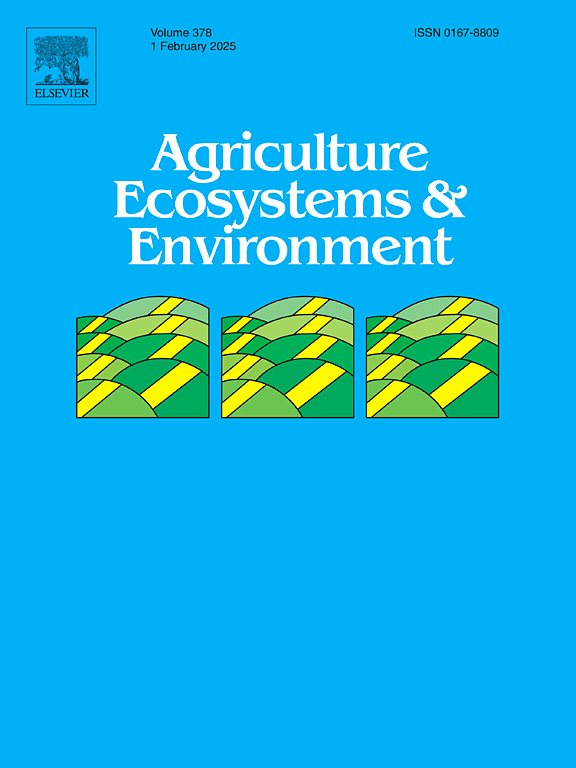土壤微生物组的宏基因组学揭示了塞拉多农业景观中的群落同质化
IF 6.4
1区 农林科学
Q1 AGRICULTURE, MULTIDISCIPLINARY
引用次数: 0
摘要
森林砍伐和土地利用集约化影响了土壤微生物群落,降低了土壤古细菌和细菌的分类和功能多样性,从而影响了关键的生态系统功能。在此,我们评估了景观结构和土壤理化性质对塞拉多生态区农业景观中微生物群落(古生菌和细菌)的影响。采用宏基因组学方法获取32个农业景观土壤微生物群落组成,并采用分段结构方程模型联合分析景观结构和土壤对分类、系统发育和功能α多样性的影响。利用随机化多矩阵回归分析了景观结构和土壤性质对群落分类学和系统发育多样性的影响。研究发现,自然植被区数量和形状对土壤微生物群α的分类、系统发育和功能多样性均有积极影响。牧草比例和NV形状对磷含量有正影响。稀树草原比例和景观组成异质性对土壤有机质含量有负向影响。然而,土壤性质对微生物群α多样性只有间接影响。不同立地间的分类和系统发育β多样性及其组成(巢性和周转)极低,与景观中NV含量和土壤铬浓度呈正相关。研究结果表明,集约化农业并没有减少古细菌和细菌的物种丰富度,而是改变了群落结构,使不同景观之间的物种组成均匀化,导致更适应集约化农业生产系统的群体占主导地位。本文章由计算机程序翻译,如有差异,请以英文原文为准。
Metagenomics of soil microbiome uncovers community homogenization in agricultural landscapes in Cerrado
Deforestation and land use intensification have been affecting the soil microbiota community, decreasing taxonomic and functional diversity of soil Archaea and Bacteria, and thus affecting key ecosystem functions. Here, we assess the influence of landscape structure and soil physico-chemical properties on microbiota community (Archaea and Bacteria) in agricultural landscapes in the Cerrado ecoregion. We used a metagenomics approach to obtain the soil microbiome community composition in 32 agricultural landscapes, and piecewise structural equation models to conjointly analyze the effects of landscape structure and soil on taxonomic, phylogenetic, and functional alpha diversity. We also analyzed the effects of landscape structure and soil properties on community taxonomic and phylogenetic beta diversity, using multiple matrix regression with randomization. We found that the number and shape of natural vegetation (NV) areas positively affected taxonomic, phylogenetic, and functional soil microbiota alpha diversity. Percentage of pasture and shape of NV had a positive influence on phosphorus content. Percentage of savanna and landscape compositional heterogeneity negatively affected soil organic matter content. However, soil properties had only an indirect effect on the microbiota alpha diversity. Taxonomic and phylogenetic beta diversity and their components, nestedness and turnover, were very low between soil sites, and positively related to the amount of NV in the landscape and soil chromium concentration. Our results show that rather than decreasing Archaea and Bacteria species richness, intensive agriculture is modifying the community’s structure homogenizing species composition between landscapes, leading to a dominance of groups more adapted to intensive agriculture production systems.
求助全文
通过发布文献求助,成功后即可免费获取论文全文。
去求助
来源期刊

Agriculture, Ecosystems & Environment
环境科学-环境科学
CiteScore
11.70
自引率
9.10%
发文量
392
审稿时长
26 days
期刊介绍:
Agriculture, Ecosystems and Environment publishes scientific articles dealing with the interface between agroecosystems and the natural environment, specifically how agriculture influences the environment and how changes in that environment impact agroecosystems. Preference is given to papers from experimental and observational research at the field, system or landscape level, from studies that enhance our understanding of processes using data-based biophysical modelling, and papers that bridge scientific disciplines and integrate knowledge. All papers should be placed in an international or wide comparative context.
 求助内容:
求助内容: 应助结果提醒方式:
应助结果提醒方式:


